Enjoy the holiday, and I’ll be back next week!

On Thursday, April 8, Vivian Lawry will be leading a discussion of The Guernsey Literary and Potato Peel Pie Society (Mary Ann Shaffer and Annie Barrows). Time: 7:30 p.m. Place:Tuckahoe Branch of the Henrico Public Library. The event is free and open to the public.

Enjoy the holiday, and I’ll be back next week!

I suppose there might be people out there who can file their annual tax returns stress-free. Congratulations! For the rest of us, condolences!

“Money is a major source of stress on people, and what tax season does is shine a great big spotlight on the issue,” Michael McKee, a Cleveland Clinic psychologist and president of the U.S. branch of the International Stress Management Association, told WebMD. “Money takes center stage at tax time, even if you might have been able to push it to the wings the rest of the year.”
A 2004 survey sponsored by the American Psychological Association found that nearly three-quarters of Americans cited money as a significant source of stress. Money is also consistently among the top causes of marital contention, says Olivia Mellan, a psychotherapist and financial self-help author based in Washington, D.C.
And nothing focuses us on money like tax time. Anyone can face the stress of having money due and too little money on hand. For those who itemize, there are additional sources of stress:
Then there are miscellaneous stresses:
But virtually every item on the topic index is rife with sources of stress. These may or may not be directly related to the taxes due, but dealing with them at tax time could well trigger strong emotions. Here is a select list:

If you are filing a joint return, remember (and remind your spouse if necessary) not to displace anger/frustration rooted in the process.

Then, too, sometimes there are ongoing issues about money. For example, if one partner is a spender while the other partner is a saver and a worrier. This can result is resentment at tax time, when a couple may examine how their habits are affecting their lives and marriage.
“Of course, we all bring our individual emotional baggage to tax preparation. Fear of the government also emerges at tax time. Some clients of financial counselor Karen McCall are so afraid of the IRS that they won’t take even the most innocuous deduction. “They’re paralyzed because the IRS is an authority figure, and if they have unresolved issues around authority figures in their lives, that can cause a lot of fear.”
Sometimes, that fear of filing taxes stems from is understandable. As Michael McKee says, people who have been through audits can suffer from post traumatic stress syndrome during tax season for years afterward.
You may not be able to avoid all stress at tax time, but consider ways to lessen it. Mellan and McCall offered these tips in a WebMD article on coping with tax stress.

Bottom Line: Tax time is stress time. You’ll just have to deal, starting with recognizing the danger zones and ameliorating as best you can.
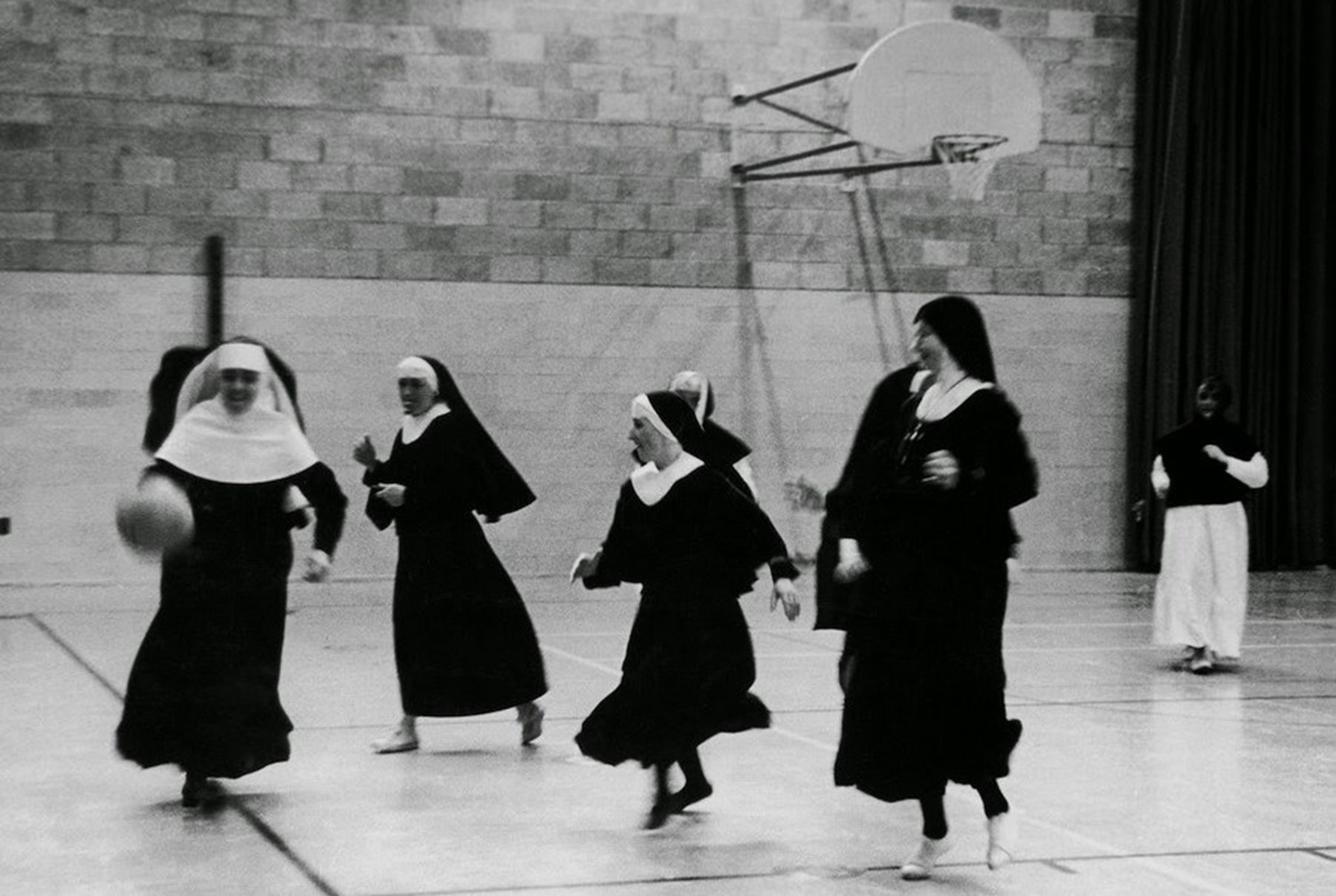
I enjoy watching athletes in a variety of sports, and basketball is one of my favorites. In honor of March Madness, I started looking into what goes on off the court. Some of the elements that make basketball so entertaining are relatively recent developments, but many have been around since the very beginning.
Basketball began in 1891, invented by James Naismith, a 31-year-old graduate student and instructor at Springfield College. Luther Gulick (then the College’s physical education superintendent, today renowned as the father of physical education and recreation in the United States) charged Naismith to come up with a new game. The goal was to create an indoor activity that college students could play during the long New England winters. The bonus was that it’s a less injury-prone sport than football. Students quickly adopted the new pastime, and it’s grown in popularity since.
Naismith’s creation was an amalgamation of many games of the time, including American rugby (passing), English rugby (the jump ball), lacrosse (use of a goal), soccer (the shape and size of the ball), and something called duck on a rock, a game Naismith had played with his childhood friends in Bennie’s Corners, Ontario. Duck on a rock used a ball and a goal that players could not rush. The goal also could not be slammed through, thus necessitating “a goal with a horizontal opening high enough so that the ball would have to be tossed into it, rather than being thrown.”
Naismith nailed two peach baskets to the lower rail of the gymnasium balcony, one at each end. An assistant stood at each end of the balcony to collect the ball from the basket and put it back into play. It wasn’t until a few years later that someone thought to cut the bottoms out of those peach baskets so the ball could fall loose. (I’ve abbreviated this history of basketball from the Springfield College website.)
The first game ended in a brawl. “One boy was knocked out. Several of them had black eyes and one had a dislocated shoulder,” Naismith said. “After that first match, I was afraid they’d kill each other, but they kept nagging me to let them play again so I made up some more rules.” (Quoted from a National Geographic article on the history of basketball.
On January 15, 1892, the Springfield College school newspaper, The Triangle, published the original basketball rules.
1. The ball may be thrown in any direction with one or both hands.
2. The ball may be batted in any direction with one or both hands (never with the fist).
3. A player cannot run with the ball. The player must throw it from the spot on which he catches it, allowance to be made for a man who catches the ball when running at a good speed if he tries to stop.
4. The ball must be held in or between the hands; the arms or body must not be used for holding it.
5. No shouldering, holding, pushing, tripping, or striking in any way the person of an opponent shall be allowed; the first infringement of this rule by any player shall count as a foul, the second shall disqualify him until the next goal is made, or, if there was evident intent to injure the person, for the whole of the game, no substitute allowed.
6. A foul is striking at the ball with the fist, violation of Rules 3,4, and such as described in Rule 5.
7. If either side makes three consecutive fouls, it shall count a goal for the opponents (consecutive means without the opponents in the mean time making a foul).
8. A goal shall be made when the ball is thrown or batted from the grounds into the basket and stays there, providing those defending the goal do not touch or disturb the goal. If the ball rests on the edges, and the opponent moves the basket, it shall count as a goal.
9. When the ball goes out of bounds, it shall be thrown into the field of play by the person first touching it. In case of a dispute, the umpire shall throw it straight into the field. The thrower-in is allowed five seconds; if he holds it longer, it shall go to the opponent. If any side persists in delaying the game, the umpire shall call a foul on that side.
10. The umpire shall be judge of the men and shall note the fouls and notify the referee when three consecutive fouls have been made. He shall have power to disqualify men according to Rule 5.
11. The referee shall be judge of the ball and shall decide when the ball is in play, in bounds, to which side it belongs, and shall keep the time. He shall decide when a goal has been made, and keep account of the goals with any other duties that are usually performed by a referee.
12. The time shall be two 15-minute halves, with five minutes’ rest between.
13. The side making the most goals in that time shall be declared the winner. In case of a draw, the game may, by agreement of the captains, be continued until another goal is made.
The website HoopTactics chronicled the major changes in basketball since those earliest years. Here are the areas of change, in chronological order. You can look them up. Virtually everything has changed!

Note: These changes apply to men’s basketball, and vary somewhat by level: high school, college, professional, international.
Women have been playing basketball almost from the very beginning. However, the road to the WNBA’s creation has not been an easy one.
Senda Berenson, a gymnastic instructor, at Smith College, Northampton, MA, introduced women’s basketball in 1893. She proposed changes to Naismith’s rules for several reasons. The original rules encouraged what many saw as unsportsman-like conduct, including violent fouls and “star playing.” (from Senda Berenson, “The Significance of Basketball for Women.” Spalding’s Official Basket Ball Guide for Women: 1901-1901 (1901)) Berenson’s changes attempted to curb this behavior and to encourage a uniform set of rules to allow for intercollegiate tournaments.
Women originally played with three zones sections with two players stationary in each section. In 1938, the three court sections where reduced to two, with two stationary guards, two stationary forwards, and two “rovers” who could move around the entire court. For decades, people commonly referred to this system as women’s half-court basketball, six-on-six basketball, or basquette.
Early organizers of collegiate women’s sports also had to confront society’s expectations of women. They had to adjust their play style to be allowed to play at all. Social mores of the time also forbade male spectators at practice and games.
Early discussions among female athletes and coaches illustrate the extremely difficult position they faced when trying to promote women’s basketball. As historian Mercedes Townsend writes, “[T]hese women largely focused on navigating through the social ideals and expectations that defined womanhood and, in turn, affected popular opinion on women’s participation in sports.” In a time when women were increasingly organizing and protesting for more economic, political, and social participation, many saw basketball as a useful tool for gender equity. “Proponents of women’s basketball considered the sport an important opportunity to showcase both the physical and intellectual ability of women, and to further validate the growing opportunities for women in the country.”
The University of California at Berkley and Stanford University played the first intercollegiate women’s game in 1896. Two teams in Illinois played the first known interscholastic women’s high school basketball game that same year.
The Amateur Athletic Union conducted the first ever women’s national championship in 1936. The International Basketball Federation (FIBA) held the first women’s world championship in 1969. In 1971 women were (finally) allowed to play full court. Louisiana Tech won the first NCAA championship in 1982. In 1995, Oklahoma was the last state to switch from court sections to full court play in high school games.
Perhaps the most important event to occur in women’s basketball, as well as all women’s sports, was the enactment of Title IX in 1972, equalizing men’s and women’s sports. Today, women’s teams play basketball with the same enthusiasm and intensity as men’s teams.
The following ten basketball facts come from the Basketball Museum of Illinois:

And then there are these fun facts from across the web:

Bottom Line: Basketball is more complex and interesting than most viewers realize.


March is one of those in-between months, not really winter and not yet reliably warm. But there are literally hundreds of occasions for celebrating in March so, much to enjoy! Here are some you probably hadn’t considered.
For example, March is Adopt a Rescued Guinea Pig Month. I will abstain, thank you very much, because I have a severe anaphylactic reaction to guinea pig dander. On the other hand, eating guinea pig—as I did in Peru—is perfectly fine. In Peru, guinea pig is a major source of protein, analogous, perhaps, to chicken in the United States.
And there is March 10, when we “spring forward” and set the clocks ahead one hour—as if anyone wants to celebrate “losing” an hour.

I’m sorry to say, we’ve already passed several great days, but feel free to mark your calendar for next year.






Weeks for those who need a little extra time to get with the program.

Month-Long Observances for those who are into party time, all the time.
Of course, March has St. Patrick’s day, (3/16) and Easter (3/31 in 2024), but they are so well-known they need no reminders. But if you haven’t already started observing the United Nations’ International Year of Camelids, you can start now. You still have ten months to celebrate llamas, alpacas, camels, dromedaries, vicuñas, etc….!
Bottom Line: There’s always a reason to celebrate in March—or at least to get involved and expand your awareness.

People of many cultures give more gifts at this time of year than any other. And sometimes, they wrap those gifts! More often than not, actually. Even if you give someone a car (!) you’ll probably go all-out and put a big red bow on top.
People have been wrapping gifts for thousands of years. In China, people used hemp and bamboo paper to wrap gifts as early as the Song Dynasty, in the 2nd century BCE.
But gift wrapping is like housework: different folks have different priorities. And also like housework, it’s better to have done than to be doing!
Lots of people (you know who you are) want every gift to be perfectly wrapped—beautiful, inviting, mouth-watering, even. This involves brand new paper, tissue, and ribbons. The pattern of the paper is perfectly aligned. The seams are folded over and creased so that the tape holding them together is invisible. Ribbons are required, wrapped at least once around the package, topped with a splendid bow, often handmade. And they must coordinate the name tags with the paper!



There are many online sources to tell/show you how to do this. Depending on the materials used, this can also be economical and/or environmentally friendly.
By contrast, the time-saver buys decorative boxes, tapes the lid on, and adds a name tag—maybe a stick-on bow. For added time-saving, they might even buy gift boxes with a bow already attached!
A close second for fast wrapping is the decorative gift bag: just open and fill. It’s second because the “wrapper” must add tissue paper to obscure the contents until time to open. (Some people skip the tissue and just rely on the bag to keep the surprise. In such cases, gift bags might be the fastest wrapping option!) Tying the handles together is optional, but you might as well, assuming you need to affix a name tag.
Gift bags have the advantage of accommodating oddly-shaped presents, and sometimes combining things in one bag can cut out the need to wrap multiple small items.
Sending gifts can be the biggest time-saver of all: order the gift and have it sent directly to the recipient. Sometimes gift wrapping is available. But the efficiency expert doesn’t really care about that.
Sometimes the time saver might just as well be labeled “easy does it.” A variation on this is gift cards. They need only an envelope, sometimes an address and a stamp. And they cut hours off shopping time.
The penny-wise wrapper saves boxes, bags, bows, ribbons, etc., from one year to the next. Wrapping paper can be trimmed of tape and rough edges and go on indefinitely, wrapping ever-smaller packages. Another money-saving habit is to cut a piece of the wrapping paper to make the name-tag. The frugal wrapper uses as little tape as possible, both to save tape and to mess-up less of the surfaces. (See below for “free” wrapping paper ideas.)

And for a most unusual option: use the paper towel or toilet paper rolls for any gift they can accommodate, fold in the ends, and decorate with markers or stickers. Amazingly, you can use decorative cookie tins to gift more than cookies (or sewing supplies)!
The environmentally aware gift-wrapper uses several of the practices mentioned above. Reusing wrapping materials keeps them out of landfills. Shipping gifts directly from the manufacturer saves one whole layer of wrapping materials. And all materials must be recyclable: no glitter or metallic paper, Styrofoam peanuts, plastic ribbons or bows. Alternative materials are also desirable. These include but are not limited to




These environmentally aware people use minimal packaging altogether, so gift-card envelopes are perfect containers.
For some people, watching the recipient open the gift is a key part of the enjoyment. For others, watching a recipient struggle to open a deviously wrapped gift is even better! These people deliberately wrap gifts to obscure the contents.



Rather than gifts or general gift cards, some people elect to give an “experience” perhaps shared with the giver
Some gifts of this type are more than “one off” experiences
When lack of money might otherwise hinder a gift-giver, they may turn to other methods of showing love and appreciation. The giver can even “wrap” these gifts in nice cards or writing them on fancy paper.
Bottom Line: Beauty, economy, speed, environmental awareness, or deviousness—you don’t have to choose just one!
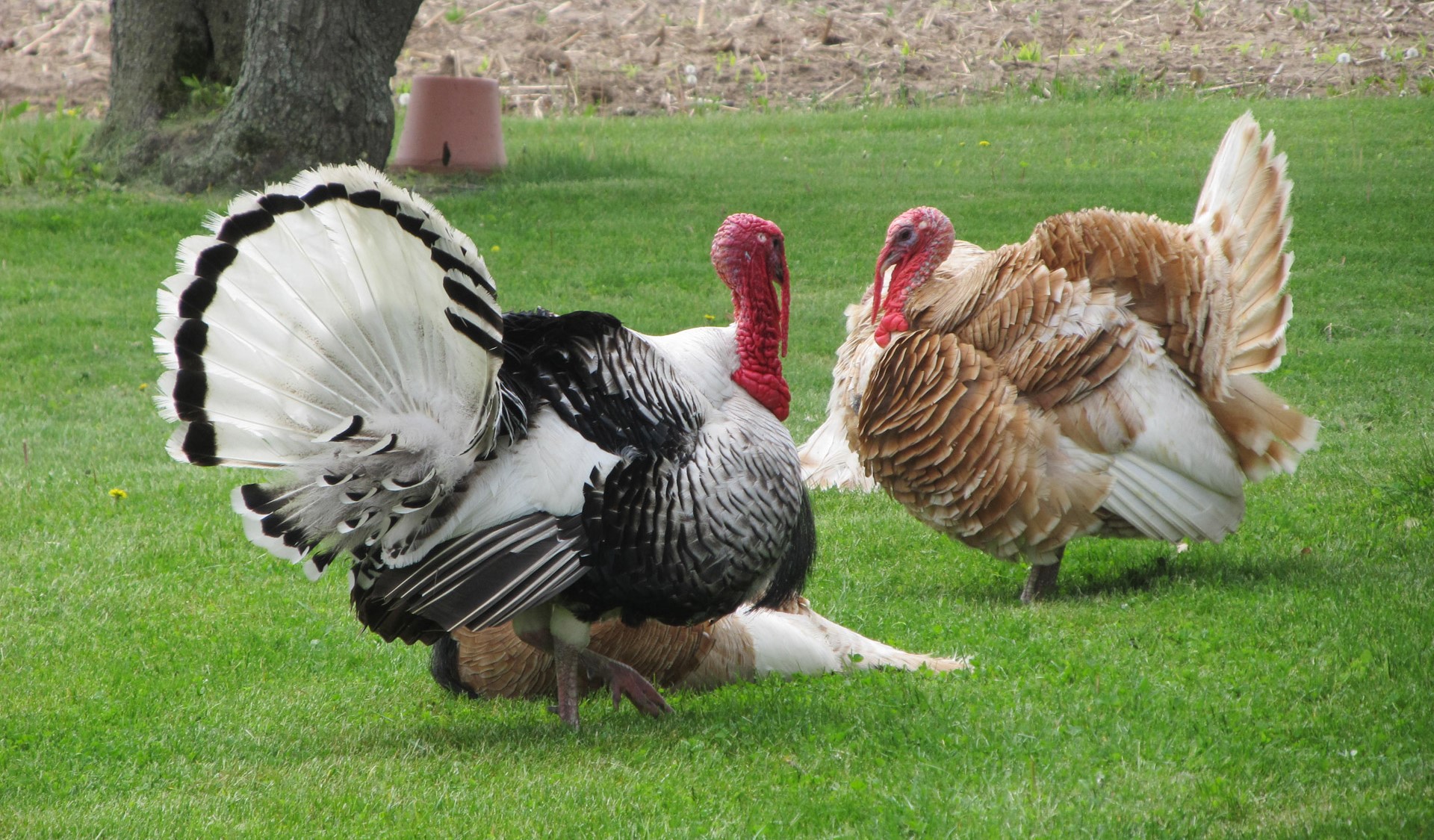
Turkey breeders domesticated farmyard turkeys from a species actually called the Wild Turkey (Meleagris gallopavo), native to the eastern and southwestern states and parts of Mexico. Last week’s blog explores turkey origins, early domestication, and return to the U.S. from Europe with colonists.
Domestic stock returned from Europe was eventually crossbred with the wild turkeys of North America. Today, there are six common standard domestic varieties in the United States:
Although wild and domestic turkeys are genetically the same species, that’s about where the similarity ends.
The domestic turkey lost its ability to fly well through selective breeding that created heavier, broad-breasted birds. The shorter legs of the domestic turkey also mean it can’t run as well as its wild cousin.
Generations of farmers have bred domesticated turkeys to have more breast meat, meatier thighs, and white feathers. (White feathers don’t leave the dark pigmentation after plucking.) Most of the turkey we eat is from the Broad Breasted White breed.
Americans consume about 736 million pounds of turkey each Thanksgiving. In 2022, Americans collectively spent approximately $1.1 billion on Thanksgiving turkeys.
One fifth of America’s annual turkey consumption is on the Thanksgiving dinner table.
Some reports say Americans consume an average of 18 pounds of turkey meat per capita each year. Other estimates suggest it’s 13.6 pounds per person. In any case, it’s more than anyone consumes at a single meal, even Thanksgiving.
While Americans prefer the white meat of turkeys, most of the rest of the world prefers the dark meat.
Avian myologists (bird muscle scientists) refer to dark meat as “red muscle.” Animals use red muscle for sustained activity—chiefly walking, in the case of a turkey. The dark color comes from a chemical compound in the muscle called myoglobin, which plays a key role in oxygen transport. White muscle, in contrast, is suitable only for short bursts of activity such as, for turkeys, flying. That’s why the turkey’s leg meat and thigh meat are dark, and its breast meat (which makes up the primary flight muscles) is white. Other more “flighty” birds, such as ducks and geese, have red muscle (and dark meat) throughout.
Creative chefs have written whole cookbooks about turkey.
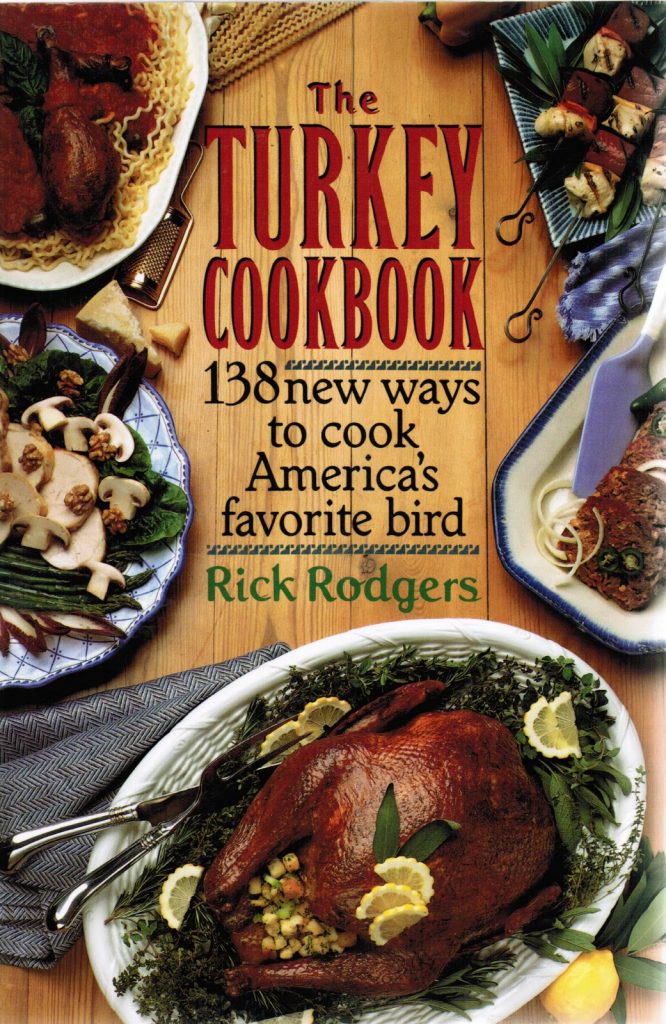


As with other cookbooks, you can find recipes for appetizers, beverages, soups, breads, salads, side dishes, sandwiches, burgers, and many uses for leftovers.
Male turkeys are sometimes called “gobblers,” after the “gobble” call they make. Alternatively, they are called “toms.” Females are called “hens.”
Many factors impact a tom turkey’s impulse to gobble. The presence of other male turkeys or of female turkeys, the weather, the time of year, and a turkey’s age all influence when and how loudly a tom turkey gobbles.
Hens make a clucking sound. Other turkey sounds include “purrs,” “yelps,” “cutts,” “cackles,” “hoots,” and “kee-kees.”
Adult gobblers weigh between 16 and 22 pounds. They have a beard of modified feathers on their chests that reaches seven inches or more long and sharp spurs on their legs for fighting.
Hens are smaller, weighing around 8 to 12 pounds. They have no beard or spurs.
Both genders have a snood (a dangly appendage on the face) and a wattle (the red, fleshy thing that hangs from a turkey’s neck). However, they only have a few feathers on the head.
Snood length is an indicator of a male turkey’s health. When males challenge each other, scientists can use snood length to predict the winner. In addition, a 1997 study in the Journal of Avian Biology found that female turkeys prefer males with long snoods.
Tom turkeys also have caruncles, visible bumps on their heads. The larger the caruncles, the more testosterone a tom has.
Turkey hens live together in flocks (called rafters) with their female young. These rafters can have 50 or more birds!
Male turkeys form their own flocks, sometimes further separated by age. At mating time, a group of related male turkeys will band together to court females. However, only one member of the group gets to mate.
Commercial poultry farms today artificially inseminate turkey eggs. Generations of selectively breeding for larger breasts has created birds too large and heavy to mate naturally.
When a hen is ready to make little turkeys, she’ll lay one egg per day, over a period of about two weeks until she has a clutch of 10 to 12 eggs. Then, the eggs incubate for about one month before hatching.
Baby turkeys (poults) eat primarily berries, seeds, and insects. An adult’s more varied diet can include acorns and even small reptiles.
A clever observer can determine a turkey’s gender from its droppings. Males produce long, thin, spiral-shaped poop. Females’ poop clumps more and looks like the letter J.
Early farmers kept turkeys on small farms not just for their meat but also because they ate large numbers of insects and so were a great source of pest control.
One of the difficulties of raising turkeys stems from their curiosity. Without sturdy and cleverly built pens, turkeys will get out of their enclosures and wander off to explore the neighborhood. Also, they tend to get into places they can’t get out of, such as nearby buildings and the pens of other animals. In particular, turkeys commonly get their heads caught in fences!
A flock of wild turkeys has caused problems at NASA’s Ames Research Center in Mountain View, California. The curious and territorial birds are big enough to deter pedestrians, stop traffic, and even halt aircraft.
Adults must teach their young to eat from special feeders and waterers, just like other baby animals.
Turkeys like to roost high up in trees where they are safe from predators and can see any danger coming. They are not always graceful when descending, often crashing from branch to branch on their way to the ground.
Turkeys have approximately 3,500 feathers at maturity. If you’re particularly industrious, you can use these feathers, along with chicken feathers, to make feather-tick bedding. It’s not nearly so light and comfy as down!
Wild turkeys swim very well. They can flatten their feathers for a stream-lined effect, steer with their tails, and kick with their powerful legs.
Turkey skins are tanned and used to make items like cowboy boots, belts, and other accessories.
The dance called the Turkey Trot was named for the short, jerky steps a turkey makes. It became very popular following its introduction in a San Francisco nightclub in 1910. The movements were so “outlandish” that authorities used to arrest people for Turkey Trotting in public, and Pope Pius X begged his flock not to follow the new dance craze.
Before modern transportation, farmers in the British Isles put leather shoes on turkeys and walked them to market.
The 57th Annual Tremont Turkey Festival was held June 9-11, 2023. The festival features footraces, bed races, horseshoes, music, a parade, food, food, food, and more.
Bottom line: (Some people think) turkeys are kind of cool.
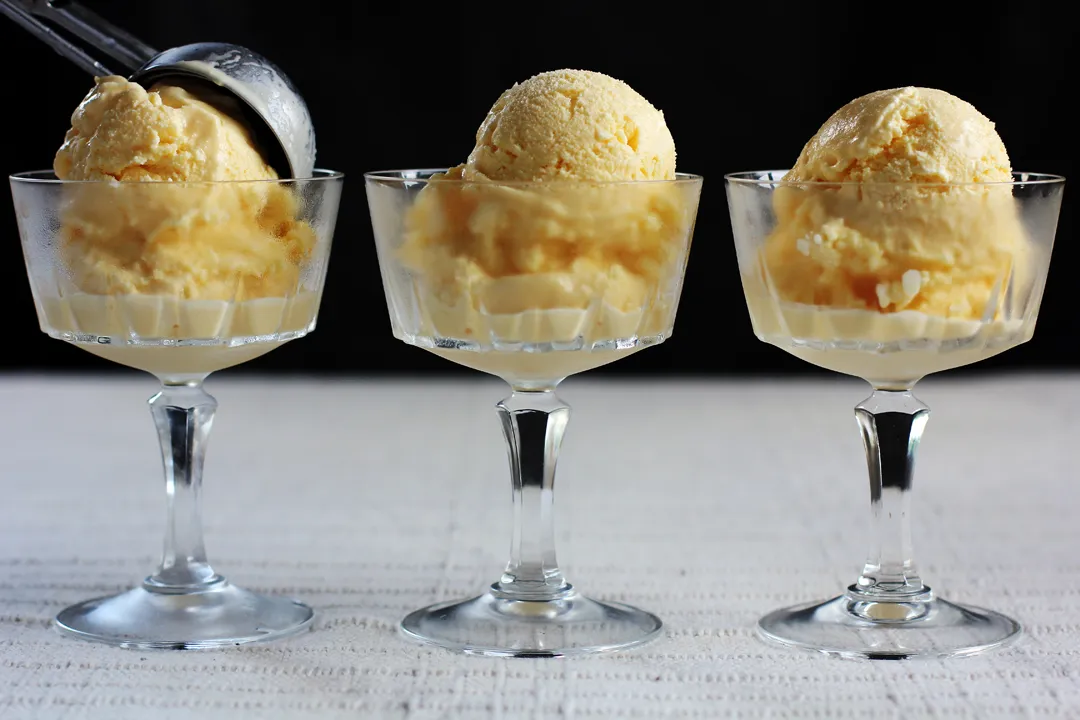
In 1984, President Ronald Reagan declared July to be National Ice Cream Month and the third Sunday of the July to be National Ice Cream Day. In doing so, he said, “Ice cream is a nutritious and wholesome food, enjoyed by over ninety percent of the people in the United States.”
But what about other presidents? Were they fans as well?
He spent $200 on ice cream during the summer of 1790—which comes to about $6,600 today—and merchant records prove it. When he moved into the President’s House, he brought 309 pieces of equipment for making ice cream, plus tasting spoons, cups, and other paraphernalia for entertaining.
From letters written by Abigail Adams, we know she and John ate ice cream with the Washingtons and perhaps made their own.
It would be hard to top Washington’s passion for ice cream, but Jefferson certainly left his mark as an ice cream devotee. In fact, historians credit him as the first American in history to write down a recipe for ice cream. It is one of only ten recipes in Jefferson’s handwriting. The recipe most likely dates from his time in France.
Although Jefferson himself did not note the source, his granddaughter recorded a virtually identical recipe later in the 19th century and attributed it to “Petit,” indicating that Jefferson’s French butler was the original source of this recipe. It is definitely in the French style. After serving as Ambassador to France, one of the souvenirs Jefferson brought home was the vanilla bean. Jefferson may have introduced the United States to vanilla in 1789.
Vanilla Ice Cream
~2 bottles of good cream
~6 yolks of eggs
~1/2 lb. sugar
~1 vanilla beanMix the yolks & sugar; put the cream on a fire in a casserole, first putting in a stick of Vanilla. When near boiling take it off & pour it gently into the mixture of eggs & sugar. Stir it well. Put it on the fire again stirring it thoroughly with a spoon. When near boiling take it off and strain it thro’ a towel. Put it in the Sabottiere [the canister within an ice pail] then set it in ice an hour before it is to be served. Put into the ice a handful of salt. Put salt on the coverlid of the Sabottiere & cover the whole with ice. Leave it still half a quarter of an hour.
Thomas Jefferson’s Recipe for Vanilla Ice Cream
Turn the Sabottiere in the ice 10 minutes; open it from time to time to detach the ice from the sides. Stir it well with the Spatula. Put it in moulds, justling it well down on the knee; then put the mould into the same bucket of ice. Leave it there to the moment of serving it.
Jefferson enjoyed ice cream so much that he had an ice house excavated on the White House grounds, in part to ensure that ice cream could be made during the summer months. Monticello had several ice houses for the same purpose. Jefferson likely helped to popularize ice cream in this country when he served it at the President’s House in Washington. There are no less than six references to ice cream being served at the President’s House between 1801 and 1809; several times guests described it being served inside of a crust or pastry.
Similar to Baked Alaska?
A small man, James Madison wasn’t a voracious eater. But he seemed always to have room for ice cream. His wife, Dolley Madison, who was truly a trendsetting first lady, loved ice cream. No doubt, she did much to popularize the dessert in America, too. We don’t know much of James Madison’s flavor preferences, but Dolley Madison preferred oyster. (At the time, there were no standard ingredients for ice cream, and early “taste testers” tried everything from grated cheese to foie gras.) In 1813, Dolley Madison served a “magnificent strawberry ice cream creation” at Madison’s second inaugural banquet at the White House.
In celebration of his inauguration on March 4, 1829, Jackson invited the American public to the White House. He was “a man of the people.” Overwhelming crowds ruined many White House furnishings and forced the new president to make a getaway through a window. They broke dishes and glasses, and generally wreaked havoc on the White House in the process. Of relevance here: among other things, the rowdy guests feasted on ice cream and cake. Staff moved the whisky punch outside, the celebrants followed, and staff handed ice cream and cake to those on the lawn through open windows.
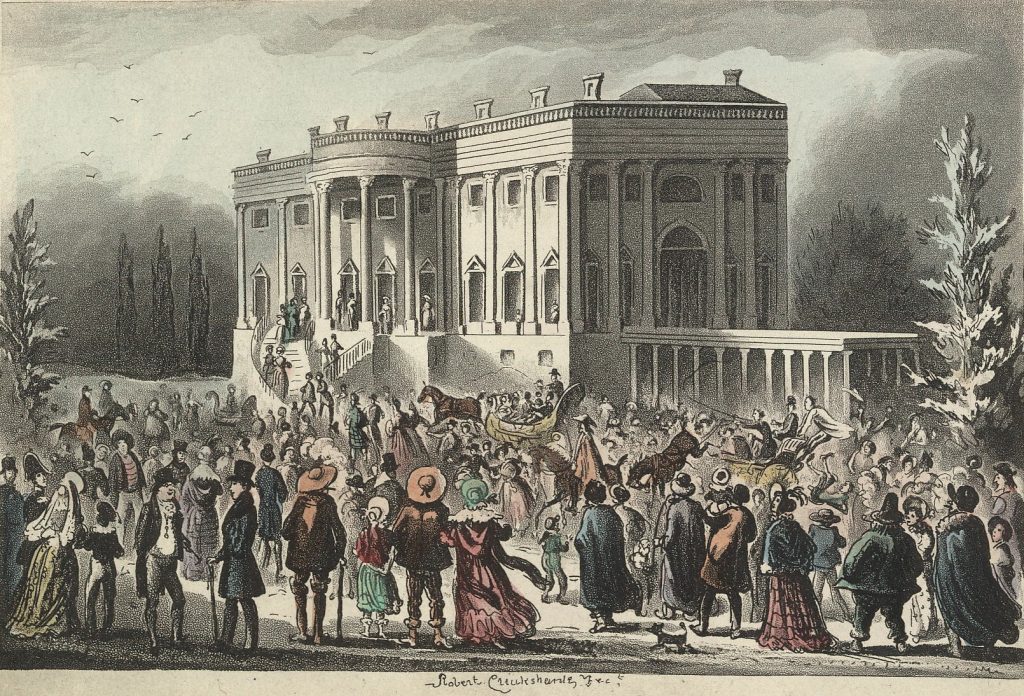
In deference to the severe economic depression during van Buren’s presidency, the White House chefs offered relatively restrained menus to residents and visitors alike. However, van Buren’s daughter-in-law Angelica Singleton Van Buren, who performed as hostess at the White House, honored the president’s Dutch roots by serving desserts popular in the Dutch community. Called oliebollen or “Dutchies”, these little donuts often were filled with currants, raisins, or candied fruit. They are said to be life-changing with ice cream, maybe pecans sprinkled on top.
Few in Washington, DC, partied like they partied at Lincoln’s second inaugural ball. The crowd of 4,000 attacked the 250-feet-long buffet table. They had much to choose from – including ice cream in “vanilla, lemon, white coffee, chocolate, burnt almonds, and maraschino” flavors, among other treats. The inaugural crowd descended like locusts on the feast, leaving the floor “sticky, pasty and oily with wasted confections, mashed cake, and debris of fowl and meat.”
While courting, McKinley once spilled a tray of strawberry ice cream all over Ida Saxton’s white dress. She didn’t hold it against him and married him on January 25, 1871.
As president, Teddy Roosevelt liked to ride his horse around the estate of the presidential physician, Dr. Presley Rixey, in Arlington. Dr. Rixey had a log cabin on his property, where the president would stop for ice cream.
Our stoutest president, Taft loved ice cream. First Lady Nellie Taft served it to guests in the Red Room three times a week. To ensure a ready supply, the Taft White House took measures: the Tafts not only added a large Peerless Ice Cream Freezer to the White House kitchen in 1912, but kept a Holstein cow on the grounds to ensure a fresh supply of milk and cream.
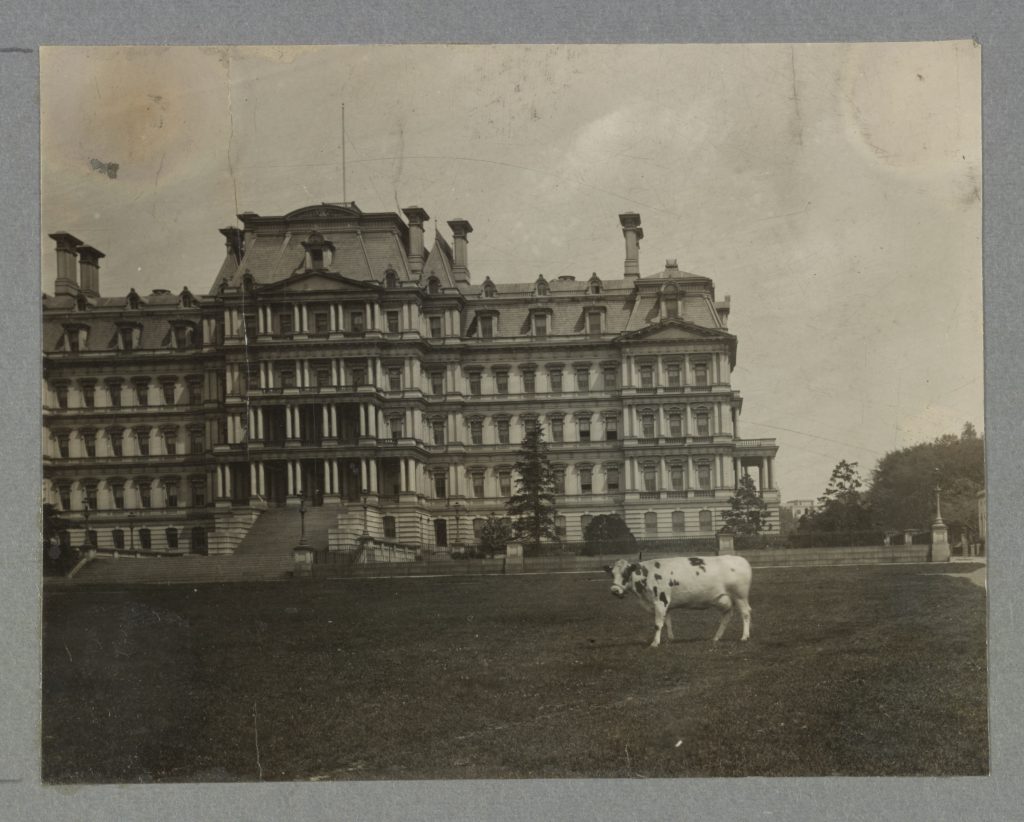
His favorite food was strawberry ice cream!
Coolidge and his wife served ice cream at a 1924 White House reception honoring World War I veterans.
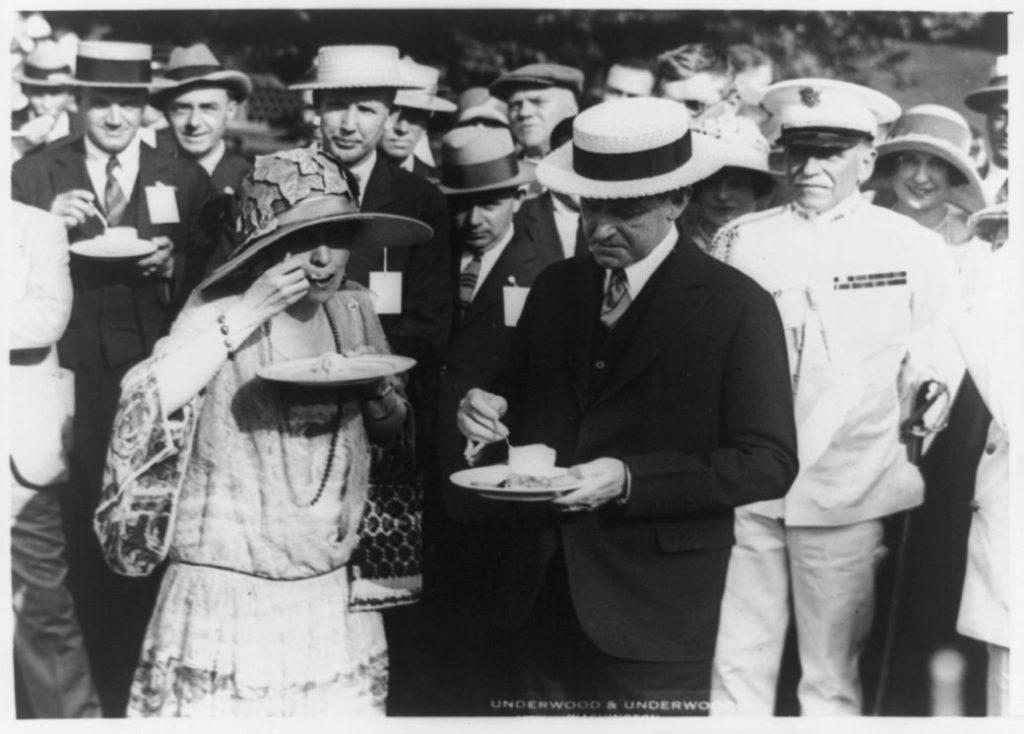
In 1923, Herbert and Lou Henry Hoover visited Seward, Alaska. While out on a walk there, Lou Henry stopped to share her ice cream cone with a small black bear cub. Not a recommended activity, but is it reasonable to assume that the couple enjoyed ice cream?
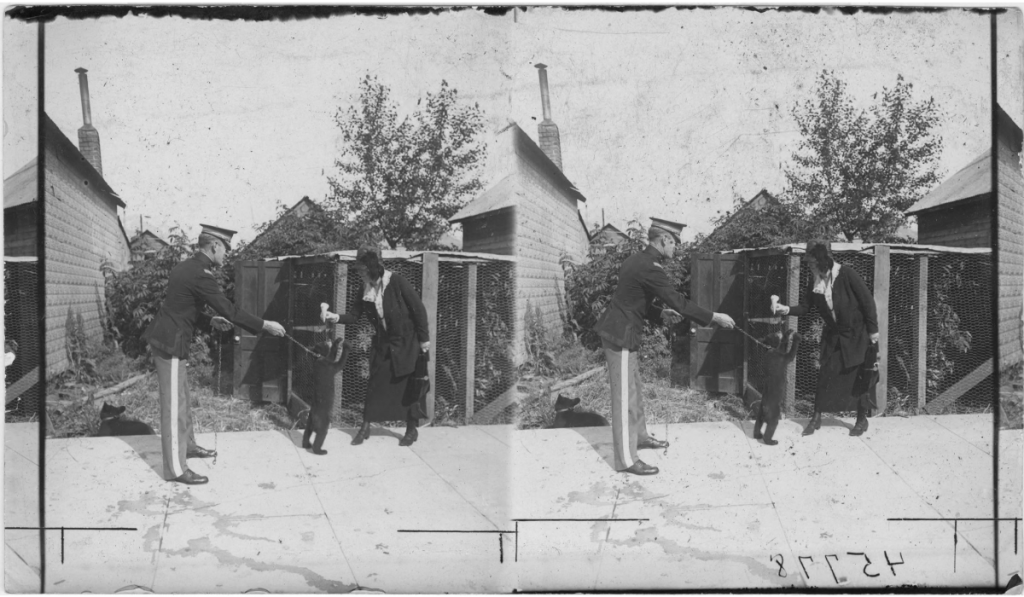
During the Depression, the Roosevelts set an example of thriftiness in entertaining, with First Lady Eleanor Roosevelt famously hosting a dinner that cost only seven and a half cents per guests. One of her favorite dishes to serve was cornmeal hasty pudding with ice cream.
In 1941, reporters at Roosevelt’s annual party for the press stayed till the wee hours. At about 1 a.m., ice cream was being served in the main hallway. Eleanor Roosevelt, who was standing behind the table, said ”Don’t you think it’s a little late for ice cream?” All took the hint and went home.
Starting at age 14, Harry Truman worked at a pharmacy and soda fountain located on West Maple Avenue in Independence, MO, now the home of Clinton’s Soda Fountain. According to their website, Harry Truman’s favorite was a butterscotch sundae with chocolate ice cream. I found confirmation that he worked there “as a boy” but not about his ice cream preferences and nothing about his actual job. So maybe this doesn’t contradict the info about Obama? (See below.)
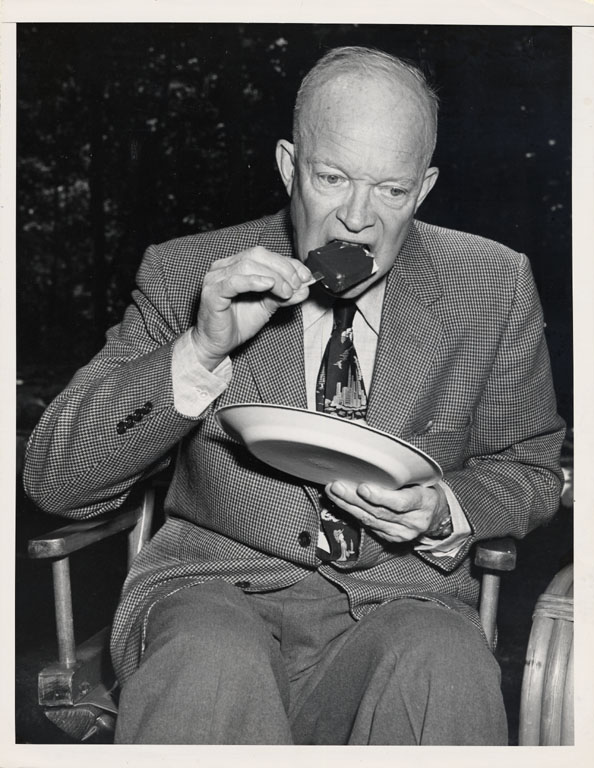
There’s a readily available photo of Eisenhower eating a Good Humor ice cream bar, but I found no context and no other info on his ice cream preferences. It may have simply been a command performance for public relations.
The Eisenhower Library has a recipe for Mamie Eisenhower’s “Frosted Mint Delight“, one of Dwight’s favorite desserts. The recipe calls for a mixture of crushed pineapple and mint apple jelly, served frozen with whipped cream, almost like ice cream.
JFK frequented Four Seas Ice Cream (a stone’s throw from the Long Dell Inn) and his favorite flavors were vanilla and peach.
As First Lady, Jacqueline Kennedy preferred French desserts, particularly bombe glacée.
Johnson’s favorite ice cream flavor was peach. Lady Bird Johnson famously served peach ice cream with lace cookies.
Peach Ice Cream
Lady Bird Johnson’s Peach Ice Cream Recipe
~3 eggs
~1 cup sugar
~1 pint milk
~1 quart whipping cream
~1/2 gallon soft peaches, peeled, mashed, and sweetened to taste
Beat eggs in a heavy saucepan until thick. Gradually add sugar, beating well. Add milk and whipping cream. Mix well. Bring to a boil, stirring constantly. Reduce heat to low. Continue cooking and stirring until mixture thickens and coats a metal spoon. Let cool.
Stir in peaches and pour into freezer can of a 1-gallon ice cream freezer. Freeze according to manufacturer’s instructions.
A well known conservationist, Lady Bird Johnson chose flower-themed desserts for her daughters’ engagement parties. White House Executive Chef Henry Haller served “flowerpot sundaes” in clay flowerpots, which he filled with layers of sponge cake, ice cream, and meringue, topped with a fresh flower.
Though he adopted the practice of eating light, Richard Nixon always had room for ice cream. Newspaper accounts during his presidency reported that, even after large state dinners, Nixon frequently finished his evening with an ice cream sundae.
In 1969, Richard Nixon requested an dessert “no one had ever seen” for a dinner celebrating astronauts Neil Armstrong, Buzz Aldrin Jr., and Michael Collins at a reception in Los Angeles. Pastry chef Ernest Mueller created marzipan and raisin ice cream globes, covered them in meringue, and served the toasted balls in pools of blackberry sauce. By all reports, the astronauts greatly enjoyed their “Clair de Lunes.“
Ford had a nearly heroic devotion to butter pecan ice cream. Whenever he visited his hometown of Grand Rapids, Michigan, his travel assistant Jon Nunn would make sure that butter pecan ice cream was always on hand. Every night he’d ask his aide, “I’ll bet there’s a little ice cream in the fridge, isn’t there, Jon?” And there always was.
Ford once told his doctor he wanted to lose 10 pounds. “That’s easy” said the physician. “Either give up your nightly martini or give up your butter pecan ice cream.” The martini was history.
Reports abound that Carter still enjoyed plenty of ice cream 3 months into hospice care—peanut butter ice cream being preferred.
In 1984, as part of Presidential Proclamation 5219, Reagan said ice cream has “a reputation as the perfect dessert and snack food” and pointed out that nearly ten percent of all the milk American dairy farmers produce every year becomes ice cream.
A few years later, he named Ben Cohen and Jerry Greenfield (of Ben and Jerry’s Ice Cream) US Small Business Persons of the Year in 1988. His well-known love of jellybeans suggests that his ice cream, whatever the flavor, would be sprinkled with jelly beans.
President Bill Clinton loved ice cream and seemed to find an ice cream shop in every place he visited. On a visit to the Penn State Bakery Creamery, chefs allowed Bill Clinton to mix his own flavors, an honor they’ve granted to no one else. (He mixed Peachy Paterno and Cherry Quist.)
Since becoming vegan, he’s opted for raspberry sorbet.
At a campaign stop in in Pennsylvania in 2006, George W. Bush ordered pralines and cream ice cream. When word got around, pralines and cream reportedly flew over the counter at that Pennsylvania ice cream shop for weeks and weeks. Although he prefers cones of praline and cream, he’ll eat vanilla custard in a pinch.
George W. Bush reportedly shipped cartons of Blue Bell ice cream from the creamery in his native Texas to the White House and to the family compound in Kennebunkport, Maine.
As far as I can confirm, Obama is the only president to have worked the counter at an ice cream shop. At age 16, he worked at a Baskin-Robbins in Honolulu. Scooping, scooping, and more scooping—hard on his wrists. In an essay about his first job, Obama admitted, “I was less interested in what the job meant for my future and more concerned about what it meant for my jump shot.”
When Barack Obama went home to Hawaii for presidential vacations, he’d enjoy confections from his youth – coconut ice cream and Hawaiian shaved ice.
Barack Obama is the only president to have a Ben and Jerry’s ice cream flavor named after him: “Yes, Pecan!” in honor of his campaign slogan “Yes, We Can!” In 2014, a Japanese ice cream company released a matcha tea flavored ice cream called “Obamatcha” to celebrate the American president’s fond memories of eating matcha popsicles as a child. A Russian ice cream company also released “Obamka” ice cream bars in 2016 in a rather odd bid to cash in on “chilling” relations between the US and Russia.
This president likes ice cream so much as a dinner dessert that the White House ushers had instructions to always slip him an extra scoop. In an interview with Time magazine, Trump boasted of having two scoops of ice cream with his chocolate pie while other diners got one.
When campaigning for vice president, he once stepped to the mic and introduced himself by saying, “My name is Joe Biden, and I love ice cream.” It’s safe to say that hasn’t changed. His favorite is Graeter’s chocolate chip. This Cincinnati-based ice cream brand has been around for about 150 years. He claimed to eat Jeni’s Splendid Ice Cream before public appearances for its performance-enhancing capabilities.
Bottom Line: Ice cream has been with us since before we were even a country. Eating it is practically a patriotic duty.


No, really: for half the earth, the Winter Solstice will begin June 21, 09:13 UTC (Coordinated Universal Time). The winter solstice marks the beginning of the return of the sun as the days get progressively longer again—and that’s always worth celebrating! Ceremonies and rituals include purification, ritual sacrifice, dancing, and sometimes gift-giving.
The Australian Aboriginal community is thought to have been the first to celebrate the winter solstice, starting as much as 65,000 years ago. About 11,000 years ago, humans in Wathaurong created the Wurdi Youang rock formation, which maps sun positions on the Equinoxes and the Summer and Winter Solstices.

For a chilly celebration, Australians join the nude solstice swim in Canberra’s Lake Burley Griffin. Participants strip down and enjoy (?) a swim in waters where temperatures are below zero-degrees. (A cold front in Canberra has caused exceptionally cold temperatures this year, making that nude dip extra refreshing!)
Elsewhere in the region, people in Tasmania celebrate for weeks, from 6 to 23 June this year. In Hobart, the capital city, the Dark Mofo Festival includes music and theater performances, art exhibits, and more.
In New Zealand’s Māori tradition, the Matariki celebration commemorates and signals the triumph of light over darkness. Events often take place at Aotearoa Stonehenge, a modern adaptation of Britain’s Stonehenge. This year, New Zealanders will celebrate Matariki as an official public holiday for the first time, following Māori customs of remembering the dead and celebrating the living.

The Eswatini of Swaziland mark the Winter Solstice with a six-day celebration of kingship called Incwala. Young men, at the direction of the king, cut branches of the lusekwane and imbondvo shrubs, which elders use to build a sanctuary hut for the king.
After days of dancing, feasting, and feats of prowess, the entire community spends a day in fasting and abstinence, including foregoing wearing jewelry, bathing, shaking hands, and sitting on chairs or mats. The elders and the king burn sacrificial objects to symbolize the ending of the old year. The king then remains in seclusion and abstinence for a month.
The Zulu celebration Umkhosi Wokweshwama (“First Fruits“) focuses more directly on the harvest. The king tastes the fruits brought from all over the country and then smashes a calabash to invite everyone to join him in feasting. Harvesting or eating before the king is a sign of disrespect. Young men of the king’s retinue sacrifice a black bull, killing it without any weapons.
British colonial authorities outlawed the Umkhosi Wokweshwama, but King Goodwill Zwelithini kaBhekuzulu revived the festival in 1990.
Incan Empire Winter Solstice traditions are still celebrated throughout much of eastern South America. Inti Raymi (“Festival of the Sun God Inti“) festivals occur annually in Ecuador, Peru, Bolivia, Chile, and Argentina.
One of the biggest Inti Raymi celebrations takes place in Cusco, the historic capital of the Inca Empire, in modern-day Peru. The festival begins with a reenactment of appeasing Inti in the center of Cusco.
Historically, the Incas fasted for three days before the solstice. Before dawn on the fourth day, they went to a ceremonial plaza and waited for the sunrise. When it appeared, they crouched down before it, offering golden cups of chicha (a sacred beer made from fermented corn). Animals—including llamas—were sacrificed during the ceremony, and the Incas used a mirror to focus the sun’s rays and kindle a fire.
After the recreation of the ancient sacrificial rites, the modern celebration continues into the city where dancers dressed in colorful traditional attire march through the narrow streets and plazas. Festivities last for days and concerts continue late into the winter night.
The Ingapirca complex is the largest set of Inca ruins in Ecuador. Here, ceremonies begin as the rising sun shines through the doorway to the Temple of the Sun. Each year nearly 10,000 visitors travel to Ingapirca to witness the coming of the new agricultural year and join the festival.
In Ecuador, ritual purification in springs and rivers is an important component of the Inti Raymi celebration. It is believed to revitalize spiritual energy and their relationship with Pachamama. Members of the indigenous community in Otavalo begin the festivities with a spiritual renewal at the nearby waterfalls at midnight. The celebrations continue with a grand march into the main plaza where members of the community and visitors sing and dance for several days.
In Bolivia, northern Chile, and southern Peru, the winter solstice (Willkakuti) marks the New Year for the Aymara People and is a time to celebrate and bless the land for bountiful harvests. More than thirty thousand people gather every year to welcome the sun at dawn. This June 2022 marks the 5,530th year of the Aymara culture.
At Tiahuanaco, in Bolivia, ceremonies start the day before the Solstice, when pilgrims travel to Quimsa Chata and Aymara priests make offerings to Pachamama, the Earth Goddess. On the as the first rays of sunlight pass through the Sun Gate to the east of the Temple of Kalasaya, celebrants raise their hands to the dawning rays.
Celebrants offer food and other sacrifices to Inti and Pachamama to bring fertility and prosperity during the start of the new agricultural period. Festivities continue throughout the night, with lots of dancing, eating, and drinking of a warm grape liquor known as signani to stay warm.
Even Antarctica gets its share of solstice celebration, thanks to the researchers staying there over the long, dangerously cold season. While the Northern Hemisphere is enjoying the most daylight hours, in the Southern Hemisphere they are celebrating Midwinter. Festivities include special meals, films, and sometimes even handmade gifts.

Bottom Line: Since ancient times, people all over the world have recognized the winter solstice as an important annual occurrence and have celebrated the subsequent “return” of the sun in a variety of ways.

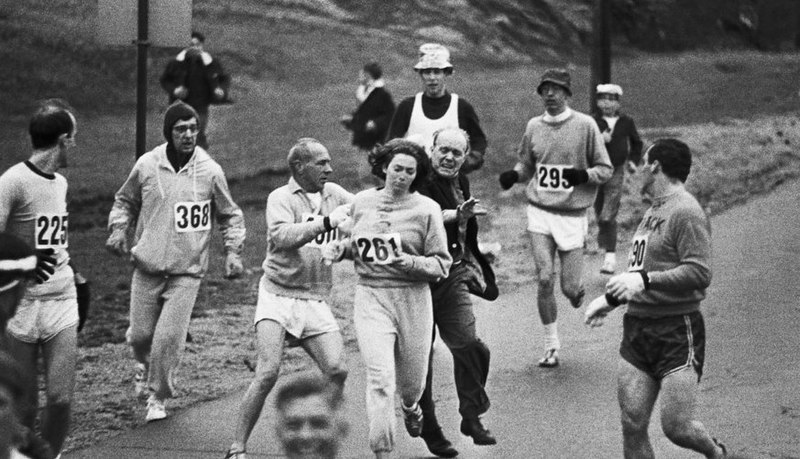
Check a thesaurus for words related to inertia. You’ll find plenty of alternatives, from attitude to Newtonian physics.
Indeed, the first dictionary definition (n) is a tendency to do nothing or to remain unchanged.
If you ask a physicist (or any one in a beginning physics class) you get a less one-sided view:
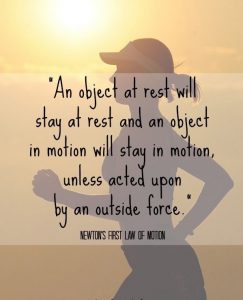
Inertia noun
In life in general, including one’s writing life, the remaining-at-rest side of inertia is typically a hurdle to overcome. In its simplest form, the longer one goes without writing (or scheduling a doctor’s appointment, sending condolences, making an apology, weeding the garden, etc.) the more effort it takes to make it happen.

Procrastination is a bear of not getting off the mark. Researchers suggest that it takes approximately 18 to 250 days to train yourself to a new habit. The first 21 days are said to be the most difficult, especially for a physical habit (regular exercise, quitting smoking, etc.).
This holds true for habits of thought, too. It’s a little more difficult to get precise numbers in this area, but studies show that you can train yourself to meditate, think positively, stop apologizing to everyone, even improve your memory. The brain, like the body, wants to remain at rest.
For humans, the continuing movement side of inertia, it seems to me, is both rarer and more beneficial. I think of it as being on a roll.
If you are on a roll, you may be having a run of good luck. (This expression, which alludes to success rolling dice, dates from the second half of the 1900s.) Enjoy it while it lasts, but the nature of luck is that it’s beyond one’s control.

Alternatively, being on a roll can mean enjoying a success that seems likely to continue. Continuing in the same habits will likely lead to a series of successes. This is true of everything from an athletic success to the first book in a popular series.

Being on a roll also means a period of intense activity. This building momentum side of inertia comes to the fore when meeting deadlines, whether work or social (like Halloween preparations).
The outside force part of the physicist’s law of inertia is where a writer’s free will comes into play. There are all sorts of things you can do to overcome inertia in your life. Identify and remove triggers for a behavior you want to change. Set reminders on a timer or a note taped to your wall.
Those outside forces can be the basis for a character’s motivation in your writing as well. Perhaps an overheard comment sparks a character’s curiosity to begin a massive research survey. Perhaps a health scare inspires a character to change jobs and move to the opposite side of the globe. Perhaps new of impending alien invasion encourages an entire planet to move all habitations below ground.
BOTTOM LINE: If you understand both sides of inertia, you can make it work for you!

In honor of International Women’s Day (March 8th), check for biases in your life, in your thought patterns, even in your writing. At its core, bias is often just mental inertia.
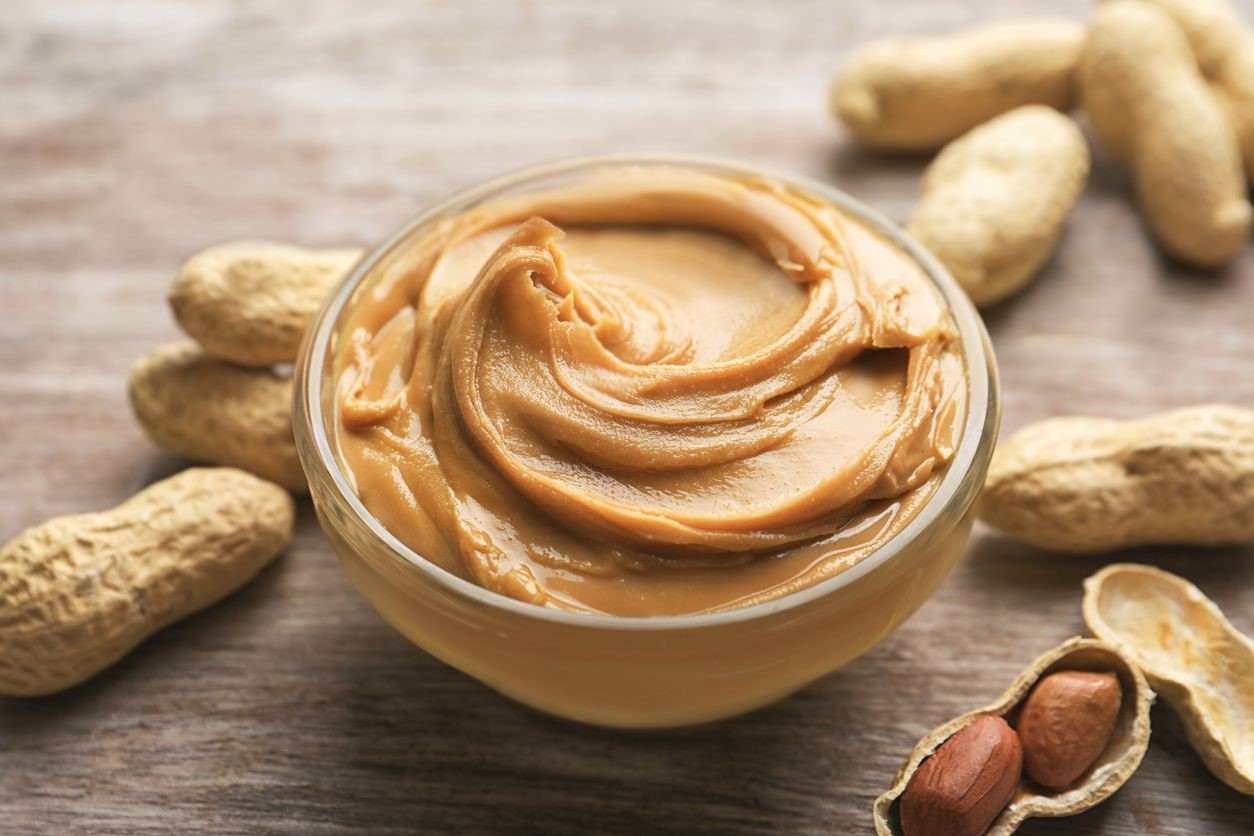
March 1 is your day: National Peanut Butter Lover’s Day. (The whole month of March is National Peanut Month.) Seeing that observance on the calendar is what prompted me to dig into the topic of peanut butter—and peanuts in general.
I’ve never been a big fan of PB&J sandwiches—sacrilege, I know, given that the National Peanut Board estimates that the average child will eat 1,500 PB&J sandwiches before graduating high school—but my earliest peanut butter love was peanut butter on pancakes with a splash of maple syrup. My father ate them that way, as did/do all his children and grandchildren. The last time I was in IHOP, my favorite wasn’t on the menu, which I found incomprehensible.
Today I still avoid PB&J sandwiches, just too sticky and soft. But I willingly eat peanut butter on toasted English muffins with jelly, honey, molasses, or bananas.
Among my other go-to options are smoothies with peanut butter, bananas, and chocolate. And speaking of chocolate, I’ve been known to swirl peanut butter with chocolate syrup for a sweet treat. Peanut butter is also great on Granny Smith apples, when I want to nod toward healthful. And let’s not forget peanut butter fudge, with or without chopped nuts, chocolate chips, etc. And trail mix. And chocolate chip cookies. And smoothies. And, and, and . . .
Writing my recent blog on snacks and snacking (February 1, 2022) I noted the following among favorite snack pairs, in descending order of popularity
What is/are your favorite combination(s)?
In 1996 I bought The Peanut Cookbook by Dorothy C. Frank, a library discard with a copyright date of 1976. But good recipes never die! Recipes are grouped in the usual categories: appetizers and nibbles; soups, salads, main dishes, vegetables; breads, biscuits, and breakfast; desserts and candies. There are dressings for vegetable salads; sauces for poultry and meat; and “syrups” for sweets. Peanut Butter Meatloaf with Sweet Potato Frosting doesn’t appeal to you? Turn the page! Even recipes that don’t tempt you to attempt are interesting to read.
One of the candy recipes is for Jimmy Carter’s favorite peanut brittle recipe.



Have I at least tempted you to check on-line recipes?

Not quite the same kind of peanuts, but I’m sure they’re delicious!
George Washington Carver was an agricultural scientist. He created more than 300 products from the peanut plant, but peanut butter was not one of them! By 1916 when he published “How to Grow the Peanut and 105 Ways of Preparing it For Human Consumption” patents related to peanut butter preparations had been granted to various pharmacists, doctors, and food scientists.
If not Carver, then who? And when? According to the National Peanut Board, there is evidence that ancient South American Inca Indians were the first to grind peanuts to make peanut butter. They speculate that the peanut plant originated in Peru or Brazil. People in South America made pottery in the shape of peanuts or decorated jars with peanuts as long 3500 years ago.
As early as 1500 B.C.E. the Incas used peanuts as sacrificial offerings and entombed mummies with peanuts to help them in the afterlife. Central Brazilian tribes ground peanuts with corn to make a drink.
But no version of peanuts or peanut plants made a direct trek north. European explorers took peanuts from South America to Spain. Explorers and traders carried peanuts to Asia and Africa. Africans introduced peanuts to the U.S./North America in the 1700s.
By 1783 Suriname had a food called peanut cheese. More solid than peanut butter, it could be sliced and served like cheese.
In the U.S., peanuts were first grown in Virginia and used for oil, as a cocoa substitute, and as food for livestock and the poor. Peanuts were considered difficult to grow and harvest. Their popularity grew (geographically and otherwise) as a result of Civil War soldiers on both sides subsisting on them (and presumably finding them tasty).
P. T. Barnum’s circus vendors called “hot roasted peanuts” for sale as they traveled across the country in the late 1800s.
Before peanut “butter,” there was peanut paste. In 1884, a Canadian named Marcellus Gilmore Edson was granted a patent for his paste, made from roasted peanuts.
Dr. John Harvey Kellogg (of cereal fame) invented a version of peanut butter in 1895, patented in 1898, that he served at his Western Health Reform Institute. Kellogg was a big proponent of plant-based food instead of meat, and for a time it was considered a food for the wealthy because they were the patrons of the expensive health care institutes. Peanut butter, like sushi and lobster, morphed from food for the poor 9and livestock) to food for the elite. But it really burst onto the public stage at the St. Louis World’s Fair in 1904.
Peanut butter became a popular source of protein during the two World Wars, being provided to troops by the Armed Forces. Recently (2020), on average, Americans ate 7.6 pounds of peanuts and peanut products each—probably even more now. In March 2020, during the COVID-19 pandemic, 299.34 million ate peanut butter; retail sales of peanut butter in the U.S. increased by 75% over the level in March 2019.
Although National Peanut Butter Day is past (January 23), there are more chances to celebrate in 2022!
Mark your calendars! And there are plenty of days open to create a peanut celebration of your own!
From the National Peanut Board, here are just a few reasons why:
FYI: it is estimated that < 1% of the population have a peanut allergy.
BOTTOM LINE: If you aren’t a peanut butter lover now, you could be!